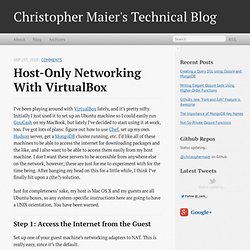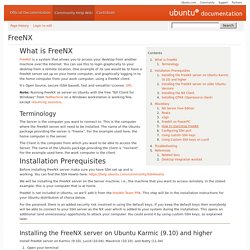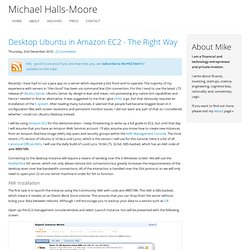

Host-Only Networking with VirtualBox - Christopher Maier's Technical Blog. I’ve been playing around with VirtualBox lately, and it’s pretty nifty.

Initially I just used it to set up an Ubuntu machine so I could easily run GnuCash on my MacBook, but lately I’ve decided to start using it at work, too. I’ve got lots of plans: figure out how to use Chef, set up my own Hudson server, get a MongoDB cluster running, etc. I’d like all of these machines to be able to access the internet for downloading packages and the like, and I also want to be able to access them easily from my host machine. I don’t want these servers to be accessible from anywhere else on the network, however; these are just for me to experiment with for the time being. After banging my head on this for a little while, I think I’ve finally hit upon a (the?)
Just for completeness’ sake, my host is Mac OS X and my guests are all Ubuntu boxes, so any system-specific instructions here are going to have a UNIX orientation. Step 1: Access the Internet from the Guest Step 3: Configure Guests … and so on. Site5 Webmaster Blog – Learn about all those internet tube things! Install WordPress on Ubuntu 11.04 Natty Narwhal. WordPress is a content management system that powers quite a variety of websites, first developed in 2003.

In WordPress’s early days, it tended to run only personal blogs and smaller sites. However, the software improved considerably with every version, and it’s adaptable enough to be used for a variety of different sites. WordPress’s big break came in 2009 when popular blogging platform Movable Type changed its licensing terms. Enough Movable Type users were annoyed with the change that they migrated to WordPress, and WordPress is the dominant open-source content management system on the Internet as of this writing. It’s quite possible to install WordPress on a machine running either the desktop or the server version of Ubuntu 11.04 Natty Narwhal. Let’s begin! (Note that the Ubuntu repositories now contain a fully automated WordPress installation.
First, install Ubuntu into your machine of choice. First, install the Apache web server. Sudo apt-get install apache2. 576359 “How to install in Lucid” : Bugs : FreeNX Server. Hi...i have installed FreeNX using the testing PPA of FreeNX team, but the upstart script doesn't seems to work, by issuing this command sudo "restart freenx-server" or "sudo service freenx-server restart" upstart says "Unknown job".

Also, on connecting (after configuring my own keys and SSHd)I can not connect, I get this on client "NX> 203 NXSSH running with pid: 5280 NX> 285 Enabling check on switch command NX> 285 Enabling skip of SSH config files NX> 285 Setting the preferred NX options NX> 200 Connected to address: 10.0.0.2 on port: 5700. FreeNX. FreeNX is a system that allows you to access your desktop from another machine over the Internet.

You can use this to login graphically to your desktop from a remote location. One example of its use would be to have a FreeNX server set up on your home computer, and graphically logging in to the home computer from your work computer, using a FreeNX client. It's Open Source, secure (SSH based), fast and versatile! License: GPL Note: Running FreeNX as server on Ubuntu with the free "NX Client for Windows" from NoMachine on a Windows workstation is working fine, except resuming sessions. Terminology The Server is the computer you want to connect to. The Client is the computer from which you want to be able to access the Server.
Before installing FreeNX server make sure you have SSH set up and is working. We will be installing the FreeNX server on the Server machine, i.e., the machine that you want to access remotely. FreeNX is not included in Ubuntu, so we'll add it from the FreeNX Team PPA. Desktop Ubuntu in Amazon EC2 - The Right Way. Thursday, 2nd December 2010 - 22 Comments Recently I have had to run a Java app on a server which required a GUI front-end to operate.

The majority of my experience with servers in "the cloud" has been via command line SSH connection. For this I tend to use the latest LTS release of Ubuntu Server. Ubuntu Server by design is lean and mean, not possessing any native GUI capabilities and hence I needed to find an alternative. It was suggested to me that I give XVNC a go, but that obviously requires an installation of the X system.
I will be using Amazon EC2 for this demonstration. Connecting to the desktop instance will require a means of sending over the X-Windows screen. AMI Installation The first task is to launch the instance using the Community AMI with code ami-9f8573f6. Open up the EC2 management console window and select Launch Instance. Click on Community AMIs and then type in ami-9f8573f6 to the right of the All Images dropdown menu. Server Configuration chmod 400 keypair.pem wget.